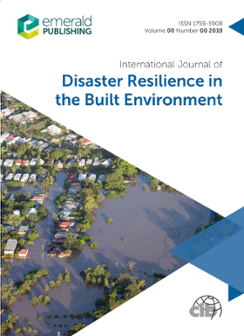International Journal of Disaster Resilience in the Built Environment: Volume 9 Issue 4/5
Table of contents
Sustainability evaluation of post-disaster housing reconstruction after 55 years: Rudak village, Iran
Niloofar Mohtat, Akbar Haji Ibrahim ZargarFocusing on Rudak, a village destroyed in the Buin-Zahra earthquake of 1962 in Qazvin, Iran, this paper aims to evaluate the reconstruction of this village in terms of…
Resiliency cube: A new approach for parametric analysis of earthquake resiliency in urban road networks
Amirpurya Chavoshy, Kambod Amini Hosseini, Mahmood HosseiniThis study aims to provide resiliency against earthquakes to the framework of an urban road network and to construct a comprehensive model with sufficient computational detail to…
Priority practices for addressing non-economic loss and damages caused by cyclones in Bangladesh: Case study of Koyra
Yohei Chiba, S.V.R.K. Prabhakar, Md. Atikul Islam, Md. Ali AkberThis paper aims to identify and prioritize key non-economic loss and damages (NELDs) caused by the 2009 Cyclone Aila in Khulna District of Bangladesh and to identify appropriate…
Contextualising mainstreaming of disaster resilience concepts in the construction process
Dilanthi Amaratunga, Chamindi Ishara Malalgoda, Kaushal KeraminiyageConstruction industry and the built environment professions play an important role in contributing to society’s improved resilience. It is therefore important to improve their…
Mapping built environment professionals’ educational needs to international policy frameworks for disaster risk reduction – community stakeholder perspective
Srinath Perera, Onaopepo Adeniyi, Solomon Olusola Babatunde, Kanchana GinigeDisaster risk reduction is prominent in the international policy agenda, and the year 2015 brought together three international policy frameworks that contribute to disaster risk…
Flood risk to commercial property: Training and education needs of built environment professionals
Namrata Bhattacharya-Mis, Jessica Lamond, Burrell Montz, Heidi Kreibich, Sara Wilkinson, Faith Chan, David ProverbsImproved management of commercial property at risk from flooding may result from well-targeted advice from built environment (BE) professionals, such as surveyors, valuers and…
Participatory action research: tools for disaster resilience education
Michelle Annette Meyer, Marccus Hendricks, Galen D. Newman, Jaimie Hicks Masterson, John T. Cooper, Garett Sansom, Nasir Gharaibeh, Jennifer Horney, Philip Berke, Shannon van Zandt, Tiffany CousinsParticipatory action research can improve scientific knowledge and community capacity to address disaster resilience and environmental justice. Evidence from the literature…
Damage functions for transport infrastructure
Nadine Habermann, Ralf HedelDamage functions constitute an essential part of the modelling of critical infrastructure (CI) performance under the influence of climate events. This paper aims to compile and…
Quantitative assessment of flood discharges and floodway failures through cross-cultivation of advancement in knowledge and traditional practices
Buddhi Wahalathantri, Weena Lokuge, Warna Karunasena, Sujeeva SetungeThe 2011 and 2013 Queensland, Australia flood events caused massive infrastructure damage for low-level stream crossings such as floodways and culverts in regional Queensland…

ISSN:
1759-5908Online date, start – end:
2010Copyright Holder:
Emerald Publishing LimitedOpen Access:
hybridEditors:
- Prof Dilanthi Amaratunga
- Prof Richard Haigh